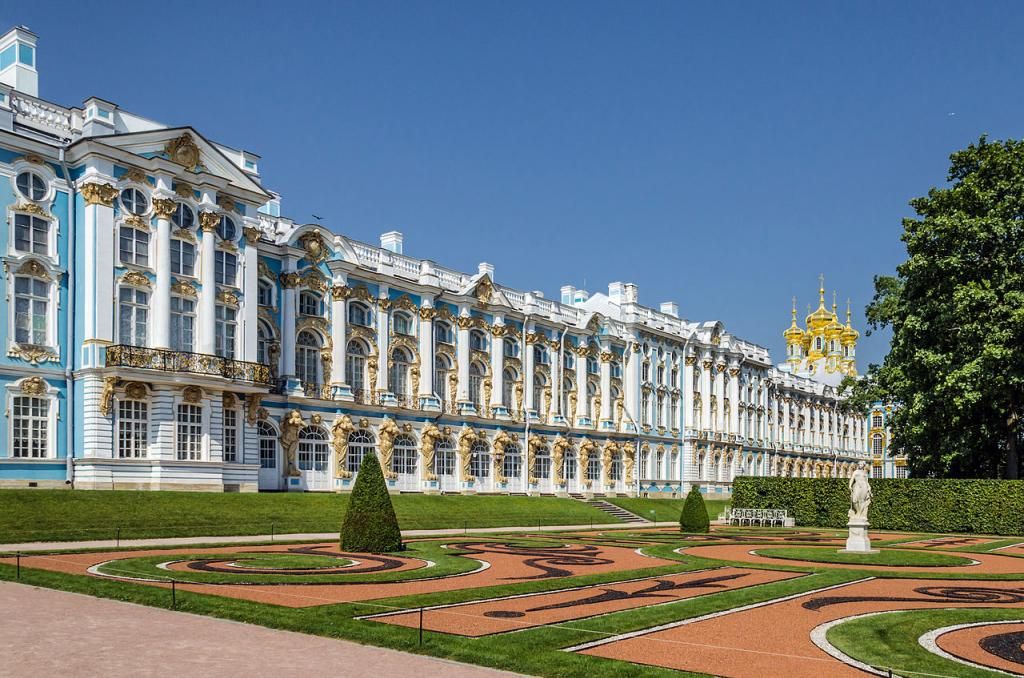The Amber Room – Part One
The legendary Amber Room, an ornately decorated chamber made of amber panels backed with gold leaf, has been described by some as the Eighth Wonder of the World due to its exquisite craftsmanship. Created in the early 18th century by German and Russian artisans, the Amber Room was given as a gift to the Russian Tsar, Peter the Great, who had it installed in the Catherine Palace of Tsarskoye Selo near St. Petersburg, where it was to remain for the next 200 years. But in 1941, a few months after the Germans invaded Russia, Nazi soldiers looted the palace, packed up the Amber Room in crates and shipped it to the German city of Königsberg, where it was put on display at the castle.

Catherine Palace, St Petersburg
After the city was bombed by the Royal Air force in 1945 the Amber Room disappeared and entered into the realms of legend and hearsay. Some researchers believe the priceless treasure to have been destroyed in the bombing of Königsberg, others that it survives in tact in a hidden bunker in the modern Russian city of Kaliningrad (previously the site of Königsberg), or was somehow spirited away to Berlin, Lithuania or even America. The discovery of one of the panels of the Amber Room by German police in 1997 has persuaded many of the hundreds of treasure hunters on the trail of the great relic that stories of its demise during WWII have been greatly exaggerated, and that the fabulous wealth of the Amber Room (reputed to be around $150 million today) is still waiting to be discovered.
Located in Tsarskoye Selo (“Czar’s Village”), a royal suburban estate now part of the town of Pushkin 12 miles south-east of St. Petersburg, the capital of the Russian Empire from 1712, the Catherine Palace was the summer residence of the Russian tsars. The first stone palace on the site was commissioned by Peter the Great for his wife Catherine I (1684-1727) and built in 1717 as a two-story residence in late Baroque style by German architect Johann Friedrich Braunstein. The Palace was substantially enlarged and modernized during the reign of Empress Elizabeth, the daughter of Peter the Great and Catherine I.
Elizabeth engaged the court architect Bartolomeo Rastrelli to rebuild the palace in a highly ornate Rococo style. Her intention was that the scale of the Palace should rival Versailles, and by 1756 it had grown to over half a mile in circumference. Over 220 pounds of gold were used to gild the stucco facade of the building and the numerous statues on its roof. Such opulent decoration and expenditure was not to everyone’s taste, however. Catherine II (1729–1796), better known as Catherine the Great, who became Empress in 1762, regarded the decoration of the Palace old fashioned and the financial outlay extravagant. Catherine made extensive changes to the Palace in line with her Classical tastes, gilded parts were painted yellow for example, and some of the interiors remodeled in Classical style.
After Catherine’s death in 1796 the throne passed to her son Paul I (reigned 1796-1801), with whom she had a particularly bad relationship. On becoming the new Tsar, Paul closed the Catherine Palace and moved the royal residence to the palace at Pavlovsk, a couple of miles away. Future Russian monarchs resided in nearby Alexander Palace, which had been commissioned by Catherine the Great for her grandson, Alexander, who became Emperor in 1801 after Paul I’s assassination. The Alexander Palace was to be the summer residence of Russia’s last ruling family, the Romanovs and where they were placed under house arrest in 1917, before their execution in Yekaterinburg a year later.
Amber
Due to its golden colour and its rarity, amber was extremely popular in the 18th century, and was often valued more highly than gold. Amber is a hard translucent fossilized resin produced by ancient trees, which has been mined in the Baltic Sea region of northern Europe since Prehistoric times. Over six tons of Baltic amber was used in the creation of the Amber Room. The Room was initially commissioned by the first king of Prussia (a historical region and former kingdom of north-central Europe, which included modern-day northern Germany and Poland) Frederick I (reigned 1701-1713) as a huge wall cover for a gallery at the Charlottenburg Palace, Berlin.
The room was designed by German baroque sculptor Andreas Schlüter (1664-1714) and crafted by Danish master craftsman Gottfried Wolfram, with assistance from Gdańsk amber masters Ernst Schacht and Gottfried Turau. Work began in 1701 on what was to become 592.015 square feet of etched and mosaic amber panels backed with gold leaf and silver. Construction of the vast room is said to have taken ten years and we know that in 1716 Frederick William I, the son of Frederick I who had died in 1713, gave the Amber Room as a gift to Tsar Peter the Great, a diplomatic move which helped secure a Prussian-Russian alliance against Sweden, who had gained control of a large part of the Baltic region during the 17th and early 18th centuries.
But Peter the Great never got around to having the Amber Room reassembled and the panels were kept in storage until his daughter Empress Elizabeth had it installed in the audience hall at the Winter Palace in St. Petersburg.




